Intel Core i9-13900K and i5-13600K Review: Raptor Lake Brings More Bite
by Gavin Bonshor on October 20, 2022 9:00 AM ESTGaming Performance: 1440p
In our Ryzen 7000 series review, we saw users commenting about testing games for CPU reviews at 1440p, so we have duly obliged here. Those interested in 1440p performance with minimal image quality – particularly the esports crowd – will be glad to know that we will be testing at this resolution going forward into 2023 and beyond.
Civilization VI
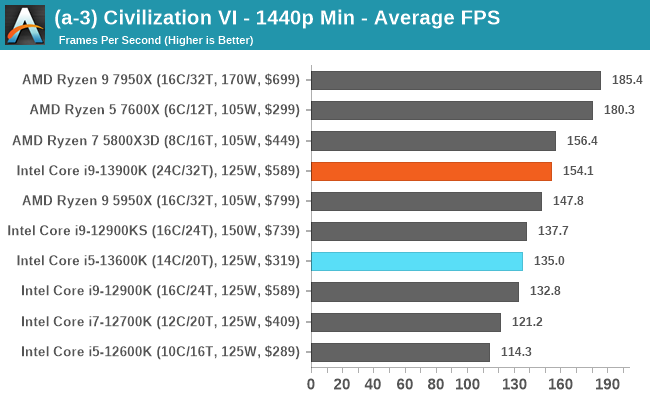

Borderlands 3
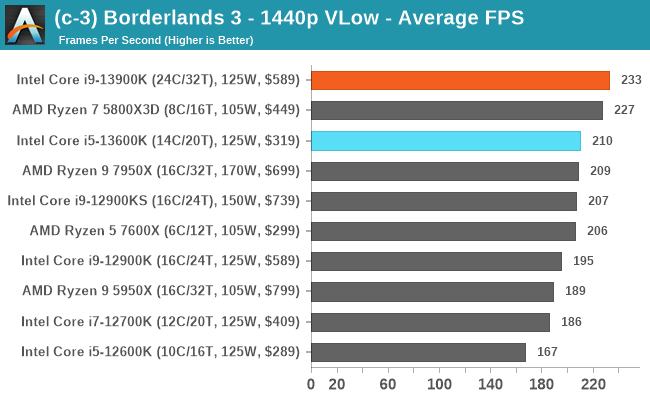

Grand Theft Auto V
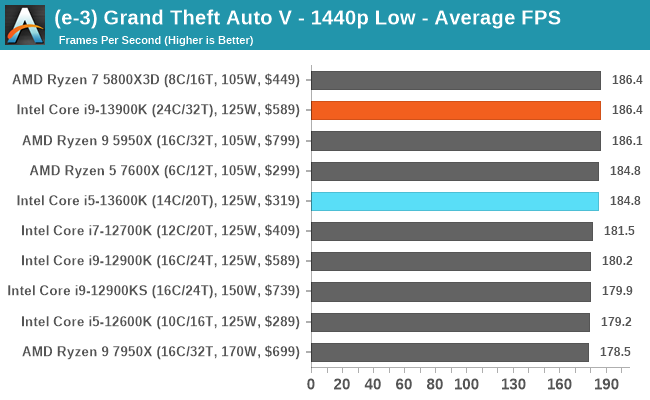
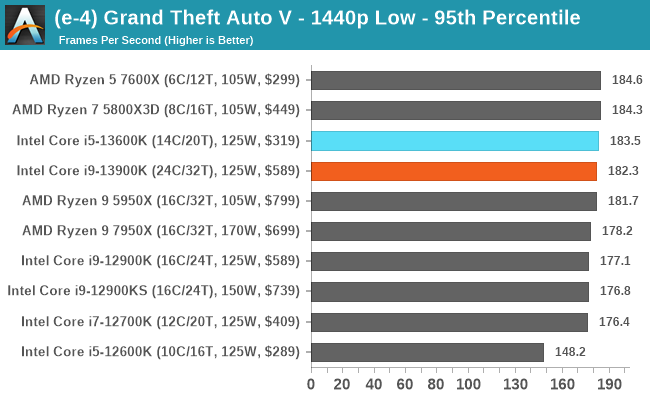
Red Dead Redemption 2
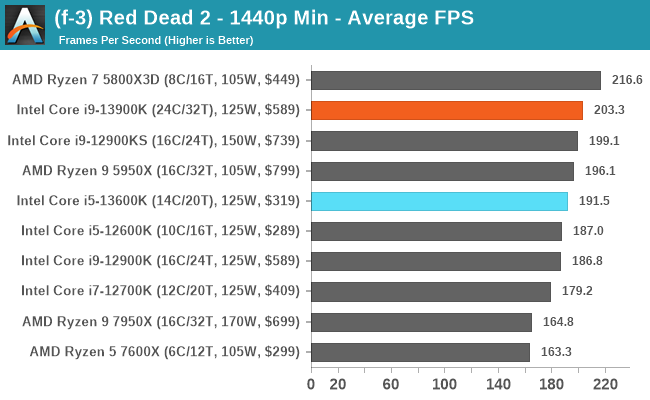

F1 2022
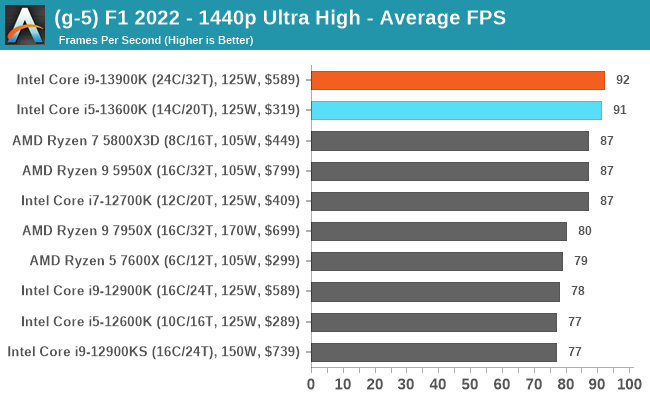
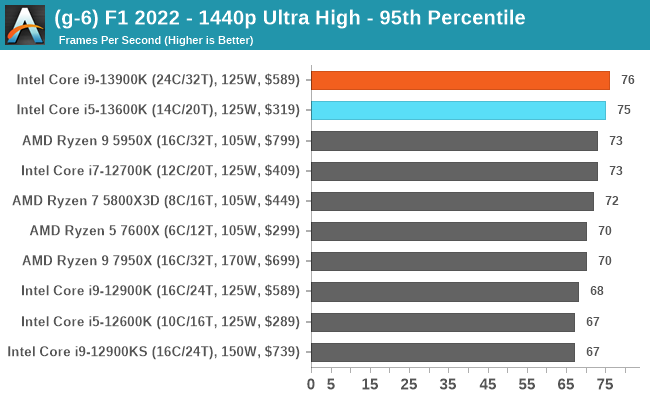
Hitman 3

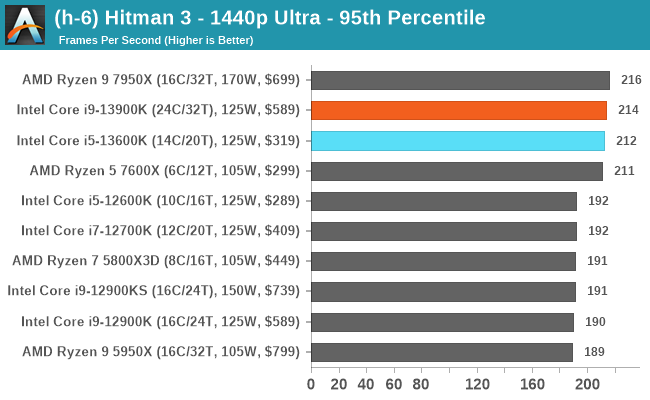
Total War: Warhammer 3

We noticed some discrepancies in our Cyberpunk 2077 testing at 1440p and 4K; we will publish these results once we identify the issue.
The first thing to note in our 1440p testing is that in Civ VI, and throughout, we've seen dominance from AMD's Zen 4 core here. I've retested numerous times to confirm, and they are correct. It's also worth noting that again, the Ryzen 7 5800X3D performs well in some of the titles, especially Red Dead Redemption 2, Grand Theft Auto V, and in Borderlands 3. If a title can utilize all of that 3D V-Cache, then the 5800X3D excels, even against the latest and great Zen 4 and Raptor Lake chips.
Throughout our 1440p testing, the latest Intel 13th Generation core has performed well, and although it gets pipped by the Core i9-12900KS in some of the tests, most of the processors are competitive in titles such as F1 2022, and Grand Theft Auto V.










169 Comments
View All Comments
flyingpants265 - Thursday, October 20, 2022 - link
That doesn't matter. All that proves is TDP is a phony measurement. If the CPU draws up to 300 watts, then it's a 300 watt CPU. Replyyh125d - Friday, October 21, 2022 - link
Exactly ReplyIketh - Friday, October 21, 2022 - link
proving TDP is a phony measurement is the entire point of that post ReplyYojimbo - Friday, October 21, 2022 - link
Firstly this discussion is not confined to Intel. All the modern CPUs use turbo clocks. They all have various performance characteristics dependent on the thermal design of the product they are in.Please cite where Intel writes that. Intel only uses TDP in its technical literature these days for the very reason that consumers are confused about it. Intel uses PL1 and PL2. TDP is the MINIMUM power that one should be designing for, not the maximum. The amount of turbo clock exposed by the cooling solution is optional, but the thermal solution associated with the processor must be capable of handling the TDP. The processor will not be damaged with a cooling solution that only handles the TDP. The processor will not use its turbo clocks much and will stay at or below the TDP power except for short periods of time. On the other hand if a cooling solution cannot handle the TDP there could he bad consequences.
Again. This isn't an Intel-specific thing. TDP and turbo clocks are ubiquitous in the industry. What is also very widespread is massive misunderstanding and misinformation about the term. Perhaps Anandtech should stop using the term with respect to CPUs because it seems to me that it's a minority of readers who understand it. Reply
Meteor2 - Saturday, October 22, 2022 - link
Reviews should stop quoting TDP. Intel no longer uses it; their latest product spec pages e.g. for the i9-13900K quote Maximum Turbo Power: "The maximum sustained (>1s) power dissipation of the processor as limited by current and/or temperature controls. Instantaneous power may exceed Maximum Turbo Power for short durations (<=10ms). Note: Maximum Turbo Power is configurable by system vendor and can be system specific."Which for the i9-13100K is 253W. Reply
Meteor2 - Saturday, October 22, 2022 - link
AMD still quotes TDP (e.g. 170W for the 7950X) with no definition of TDP provided, which I would suggest IS misleading. Replyat_clucks - Monday, October 24, 2022 - link
Ah, not confined to Intel, solid argument that it's not a problem to do it but that "people are uneducated". Scale matters. When your real power consumption is 120% over the advertised one (see link below) this isn't an "everybody's doing it" but it is indeed a matter of "people are uneducated". At this time Jimbo, anyone trying to find excuses for Intel, and downplaying the shenanigans is _really_ uneducated, was born yesterday, or benefits from the lie.This doesn't mean you should stop using Intel if it does the job for you,. But only a fool or the fraudster would defend or downplay what they're doing.
https://images.anandtech.com/graphs/graph17585/130... Reply
catavalon21 - Sunday, November 20, 2022 - link
"Please cite where Intel writes that."Step right up, folks...
https://www.intel.com/content/www/us/en/support/ar... Reply
Truebilly - Friday, October 21, 2022 - link
🫳🎤 ReplyHarryVoyager - Friday, October 21, 2022 - link
Doesn't especially matter whether they are conforming to the technical definition or not as it is tells me nothing useful about the CPU in the context in which it is presented. Reply